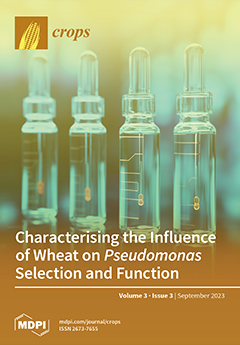Post-flowering drought tolerance (stay-green) in grain sorghum (
Sorghum bicolor (L.) Moench) is an important agronomic trait in many arid and semiarid environments throughout the world. Stay-green has been associated with increased grain yields, as well as resistance to lodging and charcoal rot
[...] Read more.
Post-flowering drought tolerance (stay-green) in grain sorghum (
Sorghum bicolor (L.) Moench) is an important agronomic trait in many arid and semiarid environments throughout the world. Stay-green has been associated with increased grain yields, as well as resistance to lodging and charcoal rot disease. Nonetheless, the relative effects of genotype, environment, and genotype × environment interactions are not well understood for this trait; similarly, the relationship between various leaf sugars and stay-green has not been sufficiently evaluated in diverse germplasm. Thus, the goals of this study were to determine the genotype, environment, and genotype by environment (GxE) effects for leaf dhurrin, sugars, and stay-green in ten diverse grain sorghum breeding lines, to evaluate the Pearson’s correlation coefficients (
r) between these traits, and to determine entry-mean repeatability (
R) for each of these traits. Of the compositional traits studied, we determined that leaf dhurrin had the highest correlation with the stay-green phenotypes (
r = −0.62). We found that stay-green sorghum lines contained approximately 2–3 times as much dhurrin as non-stay-green lines, with B1778 containing the highest concentration of dhurrin (84.8 µg/cm
2) and Tx7000 containing the least (20.9 µg/cm
2). The differences between the environments for several of the traits were high, and all the traits examined had high repeatability (
R = 0.89–0.92). These data demonstrate a relationship between leaf dhurrin and the stay-green phenotypes in sorghum, and further study will allow researchers to determine the causal effect that dhurrin has on post-flowering drought tolerance in sorghum.
Full article





